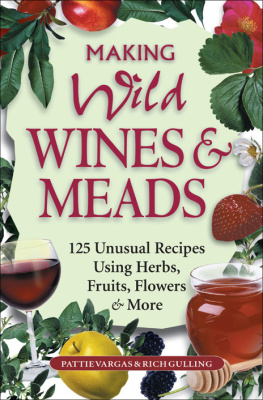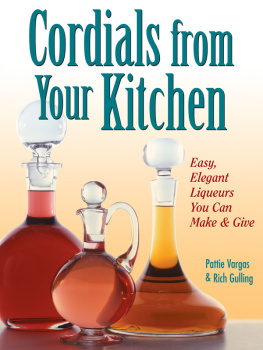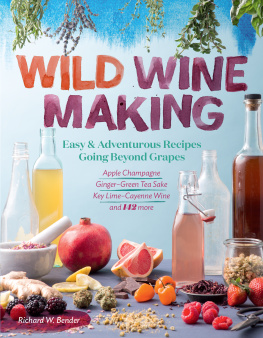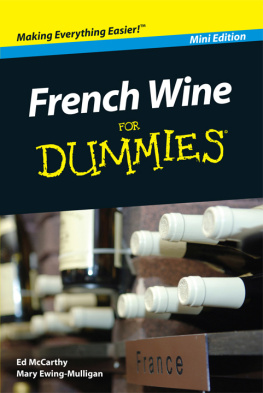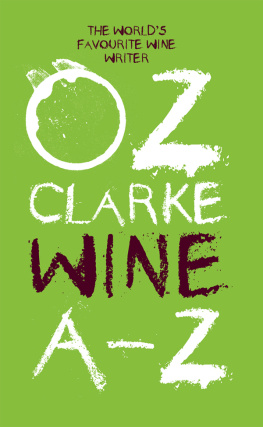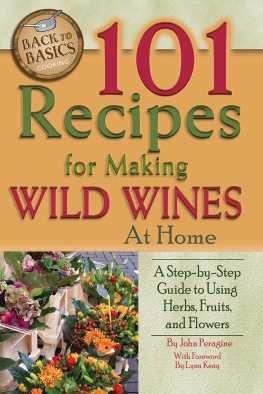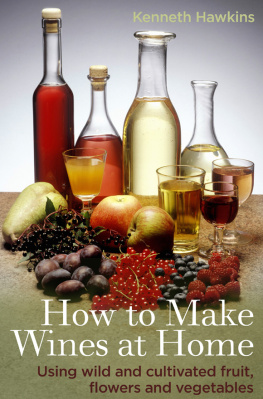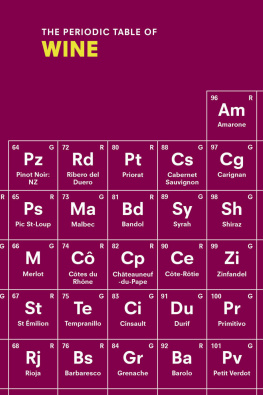Other Storey Titles You Will Enjoy
Cellaring Wine, by Jeff Cox.
A sourcebook to create a system for selecting wines to age,
storing them properly, and drinking them when they are just right.
272 pages. Paper. ISBN 978-1-58017-474-9.
Cider, by Annie Proulx and Lew Nichols.
Thorough coverage of every step of cider making, from choosing
and planting the best apple varieties to making sweet and hard
ciders, sparkling cider blends, and cider-based foods.
224 pages. Paper. ISBN 978-1-58017-520-3.
From Vines to Wines, by Jeff Cox.
A complete home winemaking education in one
book from planting vines to pulling the cork.
256 pages. Paper. ISBN 978-1-58017-105-2.
Fruits and Berries for the Home Garden, by Lewis Hill.
Instructions for the beginner and bushels of tips
for people whove been growing fruits for years.
280 pages. Paper. ISBN 978-0-88266-763-8.
The Home Winemakers Companion, by Gene Spaziani and Ed Halloran.
A guide for all levels, starting with your first batch of kit wine
to mastering advanced techniques for making wine from fresh grapes.
272 pages. Paper. ISBN 978-1-58017-209-7.
Landscaping with Fruit, by Lee Reich.
A complete, accessible guide to luscious landscaping from
alpine strawberry to lingonberry, mulberry to wintergreen.
192 pages. Paper. ISBN 978-1-60342-091-4.
Hardcover with jacket. ISBN 978-1-60342-096-9.
The Winemakers Answer Book, by Alison Crowe.
A reassuring reference that offers proven solutions to every winemaking
mishap, written by WineMaker magazines Wine Wizard.
384 pages. Flexibind. ISBN 978-1-58017-656-9.
These and other books from Storey Publishing are available
wherever quality books are sold or by calling 1-800-441-5700.
Visit us at www.storey.com .
Chapter One
WINEMAKING MADE EASY
A few purists still think that the only good wine is a grape wine. Making Wild Wines & Meads is a book that may change their minds. Making wines and meads from fruits, vegetables, flowers, grains, honey, and herbs is an age-honored hobby whose time has come again. Now, making wonderful homemade wines from these natural and unusual ingredients has never been easier.
THE BASICS
If you are just getting your feet wet as a winemaker, here are a few basics. Finished wines contain from 7 to 14 percent alcohol (by volume) created by fermentation. For a solution to ferment, only three components are necessary sugar, yeast, and nutrients. The rest of the ingredients in most recipes provide the flavors or improve the character and keeping quality of the wine. Heres how the process works: Yeast is a fungus with a sweet tooth. Feed it sugars and nutrients in solution, and the reward is alcohol and carbon dioxide the by-products of the yeasts growth. The yeast continues to grow and multiply as long as it feels at home.
Yeasts generally have a few working rules that are strictly enforced. Violate the rules and they go on strike. Too little sugar, too much alcohol, too high or too low a temperature, too few nutrients any of these will stop fermentation. Yeast does not like competition for the available nutrients and sugars, either. Let in bacteria, and there goes the neighborhood! As bacteria multiply, they create their own by-products. Some result in spoilage; one bacteria called acetobacter turns wine into vinegar. Most of the equipment and supplies youll need to make wine help keep the ideal environment for yeast, so it will grow and produce wine. That means keeping out the bacteria and, in the later stages of fermentation, the oxygen, so the yeast can produce alcohol most efficiently.
WINEMAKING EQUIPMENT
Winemaking equipment generally falls into two categories: the essential and the nice to have. Essential equipment includes those things that are needed at each part of the process. You will probably have some of the essential equipment in your kitchen already, and the rest you should be able to purchase rather inexpensively from a home winemaking supply store or mail-order catalog.
Essential Winemaking Equipment
If you are just beginning, the list on page 3 will provide you with the bare-bones equipment necessary to make your first batch of wild wine. Here are a few pointers:
Large Soup Kettle. This will be used for a number of purposes. The most important use is to heat those components of your wild wines that need cooking to release the flavors. Do not use iron or chipped enamel pots, or brass or copper kettles. Because wines and major wine ingredients are essentially acid, they can react with metals to form metal salts, some of which are toxic. In addition to the possible health hazard, these metals may react with fruit acids to make your wines hazy. Similarly, these same components may discolor aluminum kettles. For all these reasons, stay away from aluminum, copper, and brass pots when making wines. Stainless steel, glass, and unchipped enamel pots are your best choices.
THE BARE ESSENTIALS
for winemaking
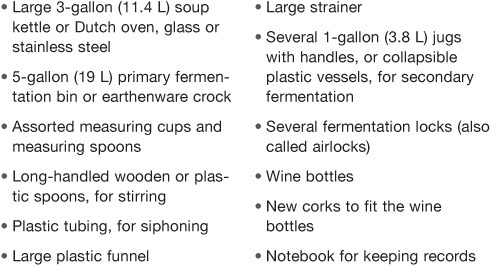
Basic winemaking equipment

Primary Fermentation Bin. The primary fermentation bin is usually made of white polypropylene a hard, smooth plastic that is relatively inexpensive, easy to clean and sterilize, and without dyes that might impart unwanted flavors. Alternative containers are earthenware crocks; large, white plastic wastebaskets; and buckets. If you use old crocks, make sure that they are free of cracks and that they have not been treated with a glaze containing lead, which could cause lead to leach into your wine. Most crocks made in the United States in modern times are free from harmful metals in their glazes, but some crocks that come from Mexico or the Middle East may still have a lead glaze. Some historians believe that lead-poisoned wine, contaminated from storage containers, contributed to the downfall of the Roman Empire, because lead poisoning causes a decline in mental acuity. If youre not sure where the crock came from, dont use it.
Finally, although plastics are generally inert materials that do not react with wine, we try to stay away from colored plastic vessels because we are not sure whether dyes will affect the quality or flavors of wines. White and clear plastic containers are easy to clean and sterilize, and psychologically, they seem to feel cleaner.
Measuring Cups, Measuring Spoons, Stirrers, Funnels, and Strainers. These may be found in most kitchens. If you are buying them especially for winemaking, make sure that they are large and made of glass, metal, or plastic so they can be sterilized easily.
Plastic Tubing. Weve always used clear plastic aquarium tubing for siphoning (also called racking) wine from one container to another. Its inexpensive, easy to clean, and free of dyes that might alter the flavor of the wine. Winemaking suppliers also carry a wide range of inexpensive tubing for racking.
Secondary Fermentation Bins. Several 1-gallon (3.8 L) jugs with handles or collapsible plastic fermentation vessels will be needed to hold your young wine during its secondary fermentation, when the fermentation slows down. Both glass and plastic bins must be able to be fitted with fermentation locks to keep out air. Glass and clear plastic are relatively inexpensive and easily cleaned. We use the collapsible fermentation vessels because they are also lightweight and portable.

